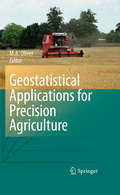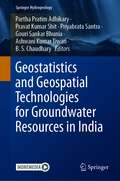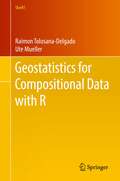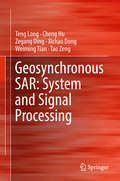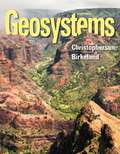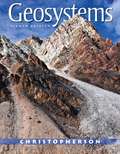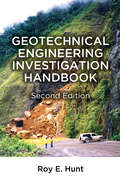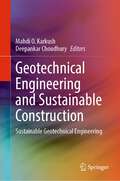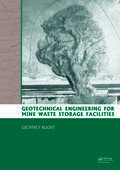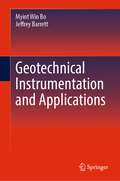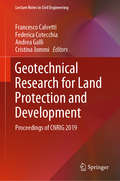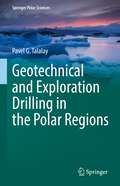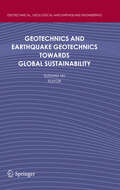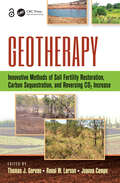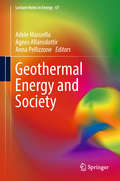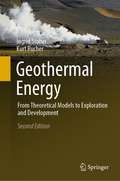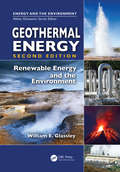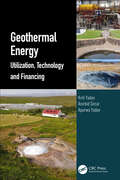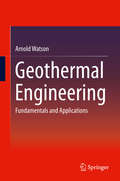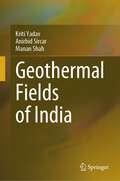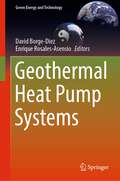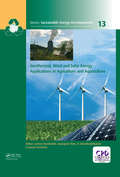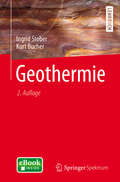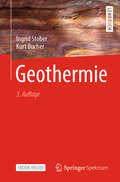- Table View
- List View
Geostatistical Applications for Precision Agriculture
by Margaret A. OliverThe aim of this book is to bring together a series of contributions from experts in the field to cover the major aspects of the application of geostatistics in precision agriculture. The focus will not be on theory, although there is a need for some theory to set the methods in their appropriate context. The subject areas identified and the authors selected have applied the methods in a precision agriculture framework. The papers will reflect the wide range of methods available and how they can be applied practically in the context of precision agriculture. This book is likely to have more impact as it becomes increasingly possible to obtain data cheaply and more farmers use onboard digital maps of soil and crops to manage their land. It might also stimulate more software development for geostatistics in PA.
Geostatistics and Geospatial Technologies for Groundwater Resources in India (Springer Hydrogeology)
by Gouri Sankar Bhunia Pravat Kumar Shit Ashwani Kumar Tiwari Partha Pratim Adhikary Priyabrata Santra B. S. ChaudharyThis book offers essential information on geospatial technologies for water resource management and highlights the latest GIS and geostatistics techniques as they relate to groundwater.Groundwater is inarguably India's single most important natural resource. It is the foundation of millions of Indian farmers' livelihood security and the primary source of drinking water for a vast majority of Indians in rural and urban areas. The prospects of continued high rates of growth in the Indian economy will, to a great extent, depend on how judiciously we can manage groundwater in the years to come.Over the past three decades, India has emerged as by far the single largest consumer of groundwater in the world. Though groundwater has made the country self-sufficient in terms of food, we face a crisis of dwindling water tables and declining water quality. Deep drilling by tube wells, which was once part of the solution to water shortages, is now in danger of becoming part of the problem. Consequently, we urgently need to focus our efforts on the sustainable and equitable management of groundwater. Addressing that need, this book presents novel advances in and applications of RS–GIS and geostatistical techniques to the research community in a precise and straightforward manner.
Geostatistics for Compositional Data with R (Use R!)
by Raimon Tolosana-Delgado Ute MuellerThis book provides a guided approach to the geostatistical modelling of compositional spatial data. These data are data in proportions, percentages or concentrations distributed in space which exhibit spatial correlation. The book can be divided into four blocks. The first block sets the framework and provides some background on compositional data analysis. Block two introduces compositional exploratory tools for both non-spatial and spatial aspects. Block three covers all necessary facets of multivariate spatial prediction for compositional data: variogram modelling, cokriging and validation. Finally, block four details strategies for simulation of compositional data, including transformations to multivariate normality, Gaussian cosimulation, multipoint simulation of compositional data, and common postprocessing techniques, valid for both Gaussian and multipoint methods. All methods are illustrated via applications to two types of data sets: one a large-scale geochemical survey, comprised of a full suite of geochemical variables, and the other from a mining context, where only the elements of greatest importance are considered. R codes are included for all aspects of the methodology, encapsulated in the R package "gmGeostats", available in CRAN.
Geosynchronous SAR: System and Signal Processing
by Teng Long Cheng Hu Zegang Ding Xichao Dong Weiming Tian Tao ZengThis book chiefly addresses the analysis and design of geosynchronous synthetic aperture radar (GEO SAR) systems, focusing on the algorithms, analysis, methods used to compensate for ionospheric influences, and validation experiments for Global Navigation Satellite Systems (GNSS). Further, it investigates special problems in the GEO SAR context, such as curved trajectories, the Earth’s rotation, the ‘non-stop-and-go’ model, high-order Doppler parameters, temporal-variant ionospheric errors etc. These studies can also be extended to SAR with very high resolution and long integration time. Given the breadth and depth of its coverage, scientists and engineers in SAR and advanced graduate students in related areas will greatly benefit from this book.
Geosystems: An Introduction To Physical Geography 9th Edition
by Robert W. ChristophersonFor Introductory Physical Geography Courses Among the most highly regarded in physical geography, Robert Christopherson's best-selling texts are known for their meticulous attention to detail, currency, accuracy, and rich integration of climate change science. Geosystems: An Introduction to Physical Geography, Ninth Edition is uniquely organized to present Earth systems topics as they naturally occur: atmosphere, hydrosphere, lithosphere and biosphere.
Geosystems: An Introduction to Physical Geography (8th Edition)
by Robert W. ChristophersonAmong the most highly regarded in physical geography, Robert Christopherson's bestselling texts are known for meticulous attention to detail, currency, accuracy, rich integration of climate change science, and strong multimedia program. Geosystems: An Introduction to Physical Geography,Eighth Edition is organized around the natural flow of energy, materials, and information, presenting subjects in the same sequence in which they occur in nature--an organic, holistic approach that is unique in this discipline. Each chapter also includes strong learning tools and a structured learning path, with Key Learning Concepts presented at the start of the chapter, Key Learning Concepts Review at the end of the chapter, and Critical Thinking questions integrated throughout. Offering current examples and modern science within a one-of-a-kind Earth systems organization, Christopherson combines student-friendly writing, outstanding art, and a strong multimedia program for a truly unique physical geography experience.
Geotechnical Engineering Investigation Handbook
by Roy E. HuntThe Geotechnical Engineering Investigation Handbook provides the tools necessary for fusing geological characterization and investigation with critical analysis for obtaining engineering design criteria. The second edition updates this pioneering reference for the 21st century, including developments that have occurred in the twen
Geotechnical Engineering and Sustainable Construction: Sustainable Geotechnical Engineering
by Deepankar Choudhury Mahdi O. KarkushThis book contains selected articles from the Second International Conference on Geotechnical Engineering-Iraq (ICGE-Iraq) held in Akre/Duhok/Iraq from June 22 to 23, 2021, to discuss the challenges, opportunities, and problems of geotechnical engineering in projects. Also, the conference includes modern applications in structural engineering, materials of construction, construction management, planning and design of structures, and remote sensing and surveying engineering. The ICGE-Iraq organized by the Iraqi Scientific Society of Soil Mechanics and Foundation Engineering (ISSSMFE) in cooperation with Akre Technical Institute / Duhok Polytechnic University, College of Engineering /University of Baghdad, and Civil Engineering Department/University of Technology. The book covers a wide spectrum of themes in civil engineering, including but not limited to sustainability and environmental-friendly applications. The contributing authors are academic and researchers in their respective fields from several countries. This book will provide a valuable resource for practicing engineers and researchers in the field of geotechnical engineering, structural engineering, and construction and management of projects.
Geotechnical Engineering for Mine Waste Storage Facilities
by Geoffrey E. BlightThe book is a comprehensive treatment of the application of geotechnical engineering to site selection, site exploration, design, operation and closure of mine waste storage facilities.The level and content are suitable as a technical source and reference for practising engineers engaged both in the design and operational management of mine waste s
Geotechnical Instrumentation and Applications
by Myint Win Bo Jeffrey BarrettGeotechnical Instrumentation and Applications explains the geotechnical issues encountered in the implementation of construction projects dealing with ground, groundwater, and earth infrastructures, including land reclamations, dams, embankments, landfill construction, excavations, and tunnelling. The book describes the types of geotechnical instrumentation available in the market and walks readers through the geotechnical issues usually encountered in construction projects and observational methods applying geotechnical instruments, planning, and implementation of geotechnical instrumentation projects. Detailed coverage of the calibration and installation process of geotechnical instruments, the verification of measured data, and the recording and documentation of as-built drawings of geotechnical instruments installed are presented. Coverage also includes methods of measurement, recommended monitoring frequencies for manual monitoring and methods of data processing and presentation, as well as analyses and interpretations of monitored data for performance assessment. Factors affecting measured instrument data are also discussed with a few examples. Case studies are presented with field data collected during the implementation of large-scale ground improvements and ground engineering projects involving extensive geotechnical instrumentation works. The book will be an ideal text for upper-undergraduate and graduate geotechnical engineering, foundation engineering, and soil mechanics courses and a hands-on reference for practitioners who apply geotechnical instrumentation in the construction industry.
Geotechnical Research for Land Protection and Development: Proceedings of CNRIG 2019 (Lecture Notes in Civil Engineering #40)
by Cristina Jommi Francesco Calvetti Federica Cotecchia Andrea GalliThis volume gathers the latest advances, innovations, and applications in the field of geotechnical engineering, as presented by leading researchers and engineers at the 7th Italian National Congress of Geotechnical Researchers (CNRIG 2019), entitled “Geotechnical Research for the Protection and Development of the Territory” (Lecco, Italy, July 3-5, 2019). The congress is intended to promote exchanges on the role of geotechnical research and its findings regarding the protection against natural hazards, design criteria for structures and infrastructures, and the definition of sustainable development strategies. The contributions cover a diverse range of topics, including infrastructural challenges, underground space utilization, and sustainable construction in problematic soils and situations, as well as geo-environmental aspects such as landfills, environmental and energy geotechnics, geotechnical monitoring, and risk assessment and mitigation. Selected by means of a rigorous peer-review process, they will spur novel research directions and foster future multidisciplinary collaborations.
Geotechnical and Exploration Drilling in the Polar Regions (Springer Polar Sciences)
by Pavel G. TalalayThis book provides a comprehensive review of drilling technologies in the polar regions, from the portable drilling equipment for shallow sampling and coring, to heavy drilling equipment for deep onshore and offshore drilling. Particular attention is given to safe drilling methods in permafrost. In recent years, interest in drilling in the polar regions has increased under the pressure of the geopolitical “rush” and the undiscovered resource potential. In addition, borehole monitoring of permafrost thermal states is urgently needed to obtain evidence of climate change. The book focuses on the latest drilling technologies but also discusses the historical development of sampling, and drilling tools and devices, over the last 60–70 years providing valuable insights into a way forward and future possibilities.
Geotechnics and Earthquake Geotechnics Towards Global Sustainability
by Susumu IaiThis book is part of a bold, new initiative towards global sustainability and development that draws on the disciplines of geotechnical engineering and earthquake geotechnics. It contains contributions from fifteen of the world's leading experts who met in Kyoto in early 2010 to discuss a range of issues related to the ways geotechnics can help us face the challenges ahead, from the technical to the social, from geo-hazards to megacities, from global warming and coastal protection to the conservation of world heritage sites. We hope these contributions will stimulate the debate over the role geotechnics has to play in achieving a more sustainable future for the world. Audience This book will be of interest to advanced levels of researchers and practicing engineers in the fields of geotechnics and earthquake geotechnics for global sustainability: the greatest long term challenge of our time.
Geotherapy: Innovative Methods of Soil Fertility Restoration, Carbon Sequestration, and Reversing CO2 Increase
by Thomas J. Goreau Ronal W. Larson Joanna CampeA Practical, Get-Your-Hands-in-the-Soil ManualGlobal climate change, increasing pollution, and continued rapid population growth is wreaking havoc on the planet. Stabilizing the environment at safe levels requires a large-scale restoration of damaged ecosystems. Geotherapy: Innovative Methods of Soil Fertility Restoration, Carbon Sequestration, and
Geothermal Energy and Society (Lecture Notes in Energy #67)
by Adele Manzella Agnes Allansdottir Anna PellizzoneThis book addresses the societal aspects of harnessing geothermal resources for different uses, such as power production, heating and cooling. It introduces a theoretical framework for a social scientific approach to the field, and presents a preliminary collection of empirical case studies on geothermal energy and society from across the world. By providing a conceptual and methodological framework to the study of geothermal energy and societies, it brings together information and analyses in the field that to date have been sparse and fragmented.The contributors explore the diverse aspects of the relationship between the harnessing of geothermal resources and the societies and local communities in which these developments take place. After introducing geothermal technologies, renewable energy concepts as well as their social and policy context and the regulative and environmental aspects of geothermal energy, the book analyzes and discusses twelve global case studies, and compares the social engagement tools applied with those used in other sectors. Of interest to researchers from a range of disciplines who wish to explore the issues surrounding energy and society, it is also a valuable resource for geothermal experts and postgraduate students wish to study the field in greater detail.
Geothermal Energy: From Theoretical Models to Exploration and Development
by Kurt Bucher Ingrid StoberThe internal heat of the planet Earth represents an inexhaustible reservoir of thermal energy known as Geothermal Energy. The 2nd edition of the book covers the geologic and technical aspects of developing all forms of currently available systems using this "renewable" green energy. The book presents the distribution and transport of thermal energy in the Earth. Geothermal Energy is a base load energy available at all times independent of climate and weather. The text treats the efficiency of diverse shallow near surface installations and deep geothermal systems including hydrothermal and petrothermal techniques and power plants in volcanic high-enthalpy fields. The book also discusses environmental aspects of utilizing different forms of geothermal energy, including induced seismicity, noise pollution and gas release to the atmosphere. Chapters on hydraulic well tests, chemistry of deep hot water, scale formation and corrosion, development of geothermal probes, well drilling techniques and geophysical exploration complete the text. This book, for the first time, covers the full range of utilization of Geothermal Energy.
Geothermal Energy: Renewable Energy and the Environment, Second Edition (Energy and the Environment)
by William E. GlassleyAn In-Depth Introduction to Geothermal EnergyAddressing significant changes in the energy markets since the first edition, Geothermal Energy: Renewable Energy and the Environment, Second Edition expounds on the geothermal industry, exploring the expansion, growth, and development of geothermal systems. This text covers every area of geothermal ener
Geothermal Energy: Utilization, Technology and Financing
by Kriti Yadav Anirbid Sircar Apurwa YadavThis book focuses on the usage of geothermal energy in countries with low-enthalpy reservoirs. It begins with the fundamentals of geothermal energy and classification of geothermal resources and their importance, including enhanced geothermal systems (EGS). Further, it discusses the creation, production, potential assessment, perspective analysis, life cycle, and environmental assessments of EGS. It describes applications in the field of geothermal energy with relevant case studies and introduces the application of machine learning techniques in the field of geothermal sectors. Features: Focuses on the development of low- to moderate-enthalpy geothermal resources Introduces machine learning tools and artificial intelligence as applied to geothermal energy Provides an understanding of geothermal energy resources and EGS Discusses the possibility of EGS using spallation and laser drilling Includes stimulation methods (thermal, hydraulic, chemical, and explosive) and case studies This book is aimed at researchers and graduate students in geology, clean energy, geothermal energy, and thermal engineering.
Geothermal Engineering
by Arnold WatsonThis book explains the engineering required to bring geothermal resources into use. The book covers specifically engineering aspects that are unique to geothermal engineering, such as measurements in wells and their interpretation, transport of near-boiling water through long pipelines, turbines driven by fluids other than steam, and project economics. The explanations are reinforced by drawing comparisons with other energy industries.
Geothermal Fields of India
by Kriti Yadav Anirbid Sircar Manan ShahThis book explores and highlights the geothermal fields of India. Until recently geothermal energy has little significance in India, therefore this book will help to provide an understanding of the potentials of Indian geothermal fields. This book will offer guidance on how to estimate the significance and resource potential of this geothermal region.The book aims to unfold the four tectonically divided geothermal regions of India namely, NW-SE Himalayan arc system with continuation to Andaman Nicobar Island, Son-Narmada-Tapti Lineament, West Coast Continental Margin and Gondwana Grabens along with Delhi Folding’s. The techniques for several direct to indirect applications of geothermal energy are described; such as power generation, desalination, honey processing, milk pasteurization, space heating and cooling, etc. This book covers the uses of geothermal water for industrial, domestic, and agricultural use. These applications increase the rate of employment in the rural and remote locations, in turn providing further societal benefits.The book also discusses the several base metal and rare earth element extractions using geothermal water, for example; lithium, zinc, manganese, and helium.This is an open access book.
Geothermal Heat Pump Systems (Green Energy and Technology)
by Enrique Rosales-Asensio David Borge-DiezThis book presents an overview of geothermal heating systems using ground source heat pumps in different countries. It evaluates the emissions and energy costs generated by the operation of low enthalpy geothermal systems, with heat pumps fed by different energy sources, and assesses, from an international point of view, those policies whose aim is a sustainable, low-carbon economy.The use of low-impact energy sources is gradually growing with the aim of reducing greenhouse gases emission and air pollution. The alternatives offered by geothermal systems are one of the key solutions for a future renewable development, enabling the electrification of heating systems and the use of biofuels.The book will be of interest to energy professionals and researchers.
Geothermal, Wind and Solar Energy Applications in Agriculture and Aquaculture (Sustainable Energy Developments)
by Guangnan Chen Jochen Bundschuh D. Chandrasekharam Janusz PiechockiThe agri-food chain consumes about one third of the world’s energy production with about 12% of it for crop production and nearly 80% for processing, distribution, retail, preparation and cooking. The agri-food chain also accounts for 80-90% of total global freshwater use where 70% alone is for irrigation. Additionally, on a global scale, freshwater production consumes nearly 15% of the entire energy production. It can therefore be argued that making agriculture and the agri-food supply chain independent from fossil fuel use has a huge potential to contribute to global food security and climate protection not only for the next decades but also for the coming century. Provision of secure, accessible and environmentally sustainable supplies of water, energy and food must thus be a priority. One of the major objectives of the world’s scientists, farmers, decisions makers and industrialists is to overcome the present dependence on fossil fuels in the agro-food sector. <P><P>This dependency increases the volatility of food prices and affects economic access to sustenance. This book provides a critical review of recent developments in solar, wind and geothermal energy applications in agriculture and the agro-food sector such as processing, distribution, retail, preparation and cooking.
Geothermie
by Kurt Bucher Ingrid StoberDas Buch bietet neben einer Einführung in die Grundlagen der Geothermie und ihre wichtigsten thermischen und hydraulischen Parameter einen Überblick über alle derzeit verfügbaren geothermischen Nutzungssysteme. Dabei behandeln die Autoren nicht nur Fragen der Effizienz und potenzieller Umweltauswirkungen, sie besprechen auch detailliert die Planung, den Bau und Betrieb von Erdwärmesonden, von hydrothermalen Anlagen und von EGS-Systemen. Themen wie der Hydraulik oder der Hydrochemie, d. h. dem Bereich Lösung und Fällung, sind eigene Kapitel gewidmet.
Geothermie
by Kurt Bucher Ingrid StoberNach einer Einführung in die Grundlagen der Geothermie werden die wichtigsten thermischen und hydraulischen Parameter in ihrer Bedeutung behandelt. Das nunmehr bereits in der 3., überarbeiteten und aktualisierten Auflage vorliegende Buch gibt einen Überblick über alle derzeit verfügbaren Nutzungssysteme der oberflächennahen und tiefen Geothermie und betrachtet diese bezüglich ihrer Effizienz und potentieller Umweltauswirkungen. Neu aufgenommen in die 3. Auflage wurden geothermische Nutzungen in Hochenthalpie-Gebieten mit Beispielen aus Island, USA und Neuseeland. Im Detail besprochen werden Planung, Bau und Betrieb von Erdwärmesonden, von hydrothermalen Anlagen, von EGS-Systemen und von Hochenthalpie-Nutzungen. Spezielle Kapitel sind der Hydraulik, d.h. der Durchführung und Auswertung hydraulischer Tests, der Hydrochemie, d.h. dem Themenbereich Lösung und Fällung, den geophysikalischen Untersuchungsmethoden an der Erdoberfläche und im Bohrloch sowie dem Abteufen und Ausbau von Tiefbohrungen gewidmet. Mit diesem Buch wird erstmalig die Geothermie in ihrer vollen Breite abgedeckt.
Geothermie
by Kurt Bucher Ingrid StoberNach einer Einführung in die Grundlagen der Geothermie werden die wichtigsten thermischen und hydraulischen Parameter in ihrer Bedeutung behandelt. Das nunmehr bereits in der 2., überarbeiteten und aktualisierten Auflage vorliegende Buch gibt einen Überblick über alle derzeit verfügbaren Nutzungssysteme der oberflächennahen und tiefen Geothermie und betrachtet diese bezüglich ihrer Effizienz und potentieller Umweltauswirkungen. Im Detail besprochen werden Planung, Bau und Betrieb von Erdwärmesonden, von hydrothermalen Anlagen und von EGS-Systemen. Spezielle Kapitel sind der Hydraulik, d.h. der Durchführung und Auswertung hydraulischer Tests, und der Hydrochemie, d.h. dem Themenbereich Lösung und Fällung, gewidmet. Mit diesem Buch wird erstmalig die Geothermie in ihrer vollen Breite abgedeckt.
